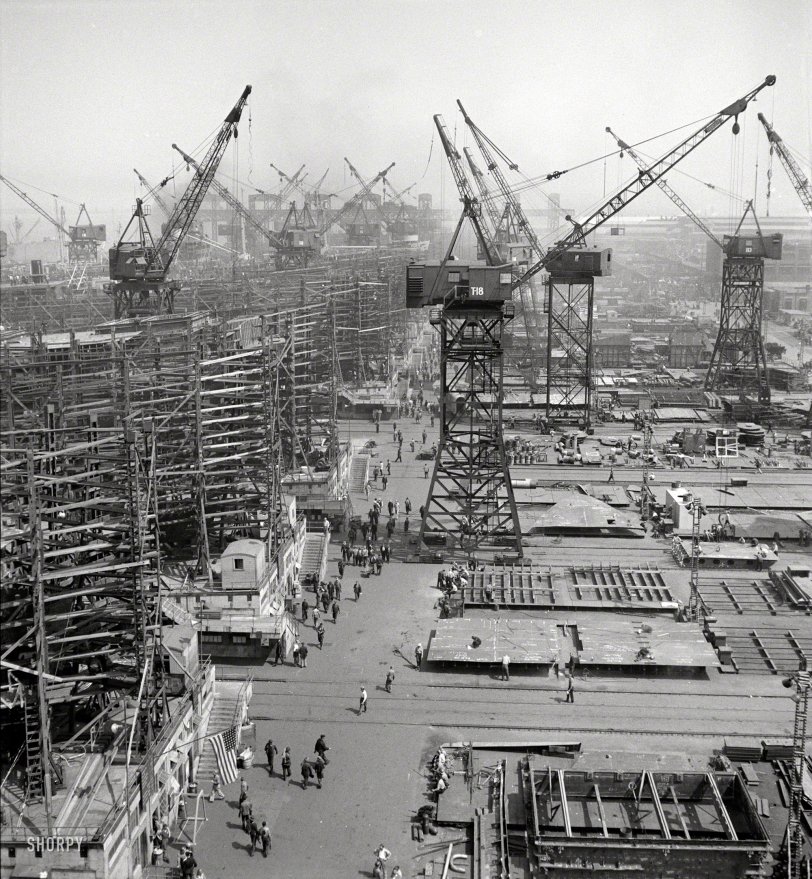


Framed or unframed, desk size to sofa size, printed by us in Arizona and Alabama since 2007. Explore now.
Shorpy is funded by you. Patreon contributors get an ad-free experience.
Learn more.

- Texas Flyer wanted
- Just a Year Too Soon
- WWII -- Replacing men with women at the railroad crossing.
- Yes, Icing
- You kids drive me nuts!
- NOT An Easy Job
- I wonder
- Just add window boxes
- Icing Platform?
- Indiana Harbor Belt abides
- Freezing haze
- Corrections (for those who care)
- C&NW at Nelson
- Fallen Flags
- A dangerous job made worse
- Water Stop
- Passenger trains have right of way over freights?
- Coal
- Never ceases to amaze me.
- Still chuggin' (in model form)
- Great shot
- Westerly Breeze
- For the men, a trapeze
- Tickled
- Sense of loneliness ...
- 2 cents
- Charm City
- What an Outrage
- Brighton Park
- Catenary Supports
Print Emporium
Bethlehem-Fairfield: 1943

May 1943. "Bethlehem-Fairfield shipyards, Baltimore. 'Liberty ship' cargo transports." Photo by Arthur Siegel, Office of War Information. View full size.
Kaiser Yards in Richmond, CA
When my father finished his sea duty tour in the Armed Guard he was assigned to San Francisco as an Assistant Port Director. One of his jobs was to inspect and sign for ships built by Kaiser in Richmond California on the Sacramento River. He said that Kaiser produced and he signed for 5 Liberty ships and 2 tankers per week in that one shipyard.
Shipbuilding Assembly Line
Baltimore Sun, September 21, 1945.Bethlehem-Fairfield's Great Building Record
The Bethlehem-Fairfield Shipyard, whose war work was brought to a close on Wednesday when four Victory ships slid down the ways, has the distinction of having built more ships during the emergency building program than any other shipyard in the world. That ought to correct any possible impression made by the ballyhoo over the shipyards on the West Coast that they and they alone did the job.
Bethlehem-Fairfield has won half a dozen pennants, including the Gold Wreath Pennant, highest award of the United States Maritime Commission. And, in addition to the distinction mentioned above, there were other impressive reasons why those awards were merited.
Bethlehem-Fairfield started virtually from scratch. There were only four ways on the site when the program began. In short order they were increased to sixteen. Bethlehem-Fairfield converted shipbuilding into an assembly-line process. No sooner was a ship launched than workman stepped forward to lay the keel for another. Building time for Liberty ship was cut from 150 days to nineteen.
Bethlehem-Fairfield in its four busy years built and launched a total of 508 ships, of which 384 were Libertys, 94 Victories and 30 landing craft. It delivered 100 Libertys in the time allotted for 50. The 508 ships totaled 5,187,800 tons, or ten per cent of the deadweight tonnage of the American merchant marine built in the emergency period.
At its peak Bethlehem-Fairfield employed 46,700 persons, so that the industrial community was a city in itself. How well it built is proved by the fact that not one of its ships ever broke in half when it went to sea, a circumstance not unknown to ships from some other yards.
Doing the job
I'm afraid we may have now forgotten what photos like this show: how an amazingly complex activity can be planned, organized, carried out, and managed entirely by human beings without computers or computer networks. It was done using paper, pencils, wallboards, typewriters, carbon paper, telephones, radios, regular mail, and teletype machines. Many of the people involved likely did not have a high school education; few had a college degree. They did it with about 20% of the population, those in prime working age and in the best health, gone into the military. And they pretty much did not see it as extraordinary -- though it most, most certainly was.
Impressive American might
Any Nazi or Japanese leaders seeing this image of U.S. strength on the job should have shuddered, knowing what American man-power and woman-power could produce at a place such as this.
The average Liberty ship could be built in 42 days, but the record was less than five days. They were correctly called "ugly ducklings" and sometimes were places of danger, but Liberty ships literally carried the freight between fighting arenas and were a prime reason we won World War II.
A Sleeping Dragon Wakes
As Admiral Yamamoto, who had studied at Harvard and spent many years in the US, put it after Pearl Harbor, "We have awakened a sleeping dragon."
This one shipyard at its peak in late 1943, employed 46,700 workers, including 6,000 African-Americans, who worked around the clock.
From the yard's opening in 1941 until its last ship, the Atlantic City Victory, slid down its ways in October 1945, the yard delivered more vessels than any other American shipyard, and even managed to establish a world shipbuilding record.
Baltimore workers had built 5,187,600 tons of shipping. They had constructed during the duration of the war, 384 Liberty ships, 94 Victories and 30 LSTs.
























On Shorpy:
Today’s Top 5